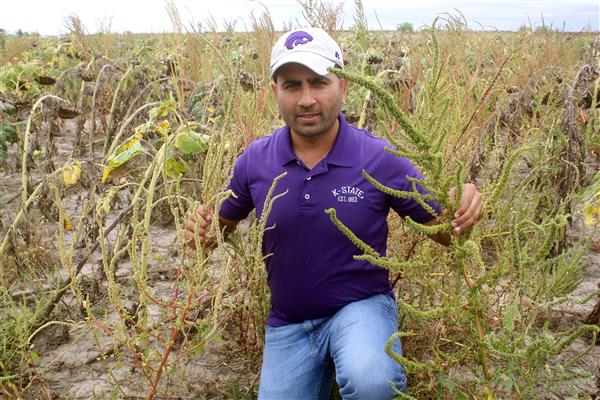Article Archives
Kansas Research: Palmer in Sunflower
Wednesday, January 29, 2020
filed under: Weeds
 KSU-Hays weed scientist Vipan Kumar holds a male Palmer amaranth plant in his right hand and a
KSU-Hays weed scientist Vipan Kumar holds a male Palmer amaranth plant in his right hand and a
female in his left hand. Under the ‘right’ conditions, a mature female can produce upwards of a half million seeds.
Though he’s been at Kansas State University’s Agricultural Research Center in Hays for only a little over two years, Vipan Kumar has considerable history to draw upon when it comes to studying Palmer amaranth and its management. Phil Stahlman, Kumar’s predecessor as KSU-Hays weed scientist, conducted extensive studies on this weed species prior to his retirement in early 2017 after 42 years with KSU. A portion of that research focused on the control of Palmer amaranth in sunflower.
Kumar has picked up that research banner and moved forward. One project, conducted in cooperation with weed scientists from the University of Nebraska and Colorado State University, has been examining the influence of rainfall on the timing and efficacy of pre/post soil residual herbicides for control of glyphosate-resistant kochia and Palmer amaranth in High Plains sunflower. This research has been partially funded by the National Sunflower Association.
According to recent surveys, glyphosate resistance has become fairly common among kochia and Palmer amaranth populations in Kansas. Glyphosate-resistant populations of Palmer amaranth were documented during Stahlman’s tenure at KSU-Hays, as was resistance to ASL-inhibiting herbicides. More recently, in 2019 Kumar and his team confirmed resistance to 2,4-D in a Palmer amaranth biotype from south central Kansas.
Speaking at the January NSA Sunflower Research Forum in Fargo, N.D., Kumar updated his audience on the scope of resistance confirmed thus far in Kansas for both kochia and Palmer amaranth. For kochia, resistance cases of multiple sites of action (SOA) include glyphosate (Group 9), ALS inhibitors (Group 2), PSII inhibitors (Group 5 and dicamba (Group 4). For Palmer amaranth, the resistance-to-multiple-SOA list includes glyphosate (Group 9), chlorsulfuron (Group 2), atrazine (Group 4), mesotrione (Group 27) and now 2,4-D (Group 4).
“A single application of BroadAxe or Spartan Elite can provide season-long kochia control and 96% control of Palmer amaranth for up to 28 days after treatment,” Kumar notes. “[But] the longevity and activity of this premix is influenced by available soil moisture.” The objectives of the current study were to (1) determine the effect of rainfall on the efficacy and longevity of PRE herbicide options, and (2) determine the optimal timing of Zidua POST, based on the applied PRE and rainfall.
The trials included three basic POST programs: Prowl H2O at 2 pt/ac; BroadAxe at 25 fl oz/ac; and Spartan Charge at 5 fl oz/ac. On top of those, they also applied a follow-up POST treatment of Zidua at 1.5 oz/ac. The sequential Zidua POST treatment went on at either two, four and six weeks after sunflower planting, targeting the sunflower growth stages of two, four and eight true leaves, respectively.
Though the study design covered two years (2018 and 2019) at five sites (Hays and Colby, Kan., Scottsbluff and Sidney, Neb., and Julesburg, Colo.), not all trials produced useful data due to hail damage and other limitations (including low weed populations). However, based on the available data gathered across sites and years, Kumar summarizes the High Plains study results as follows:
- BroadAxe-based programs provided effective, season-long control of kochia and Palmer amaranth.
- No additional benefit was seen from adding Zidua POST treatments to the PRE programs.
- Prowl- and Spartan Charge-based programs had moderate to excellent control across sites and years.
The KSU-Hays weed scientist also offers these observations when it comes to controlling kochia and Palmer amaranth in High Plains sunflower specifically:
- Be proactive. Monitor and manage kochia flushes in February and March, and Palmer amaranth in April and May, by using appropriate labeled PRE and POST burndown options.
- Early season control is critical since Palmer plants germinate and emerge over such a long period — even into September.
- Preplant burndown is important, since by the time sunflower is planted in early or mid-June, there will have been a couple flushes of kochia and Palmer. “Exploit” their seed banks before they become a problem in the crop.
- If struggling with glyphosate-resistant kochia and Palmer, go with another burndown product, such as gramoxone. Put down some PRE with the burndown as well.
- Consider growing a cover crop, either fall or spring planted — and then terminate the cover by late April to mid-May.
— Don Lilleboe